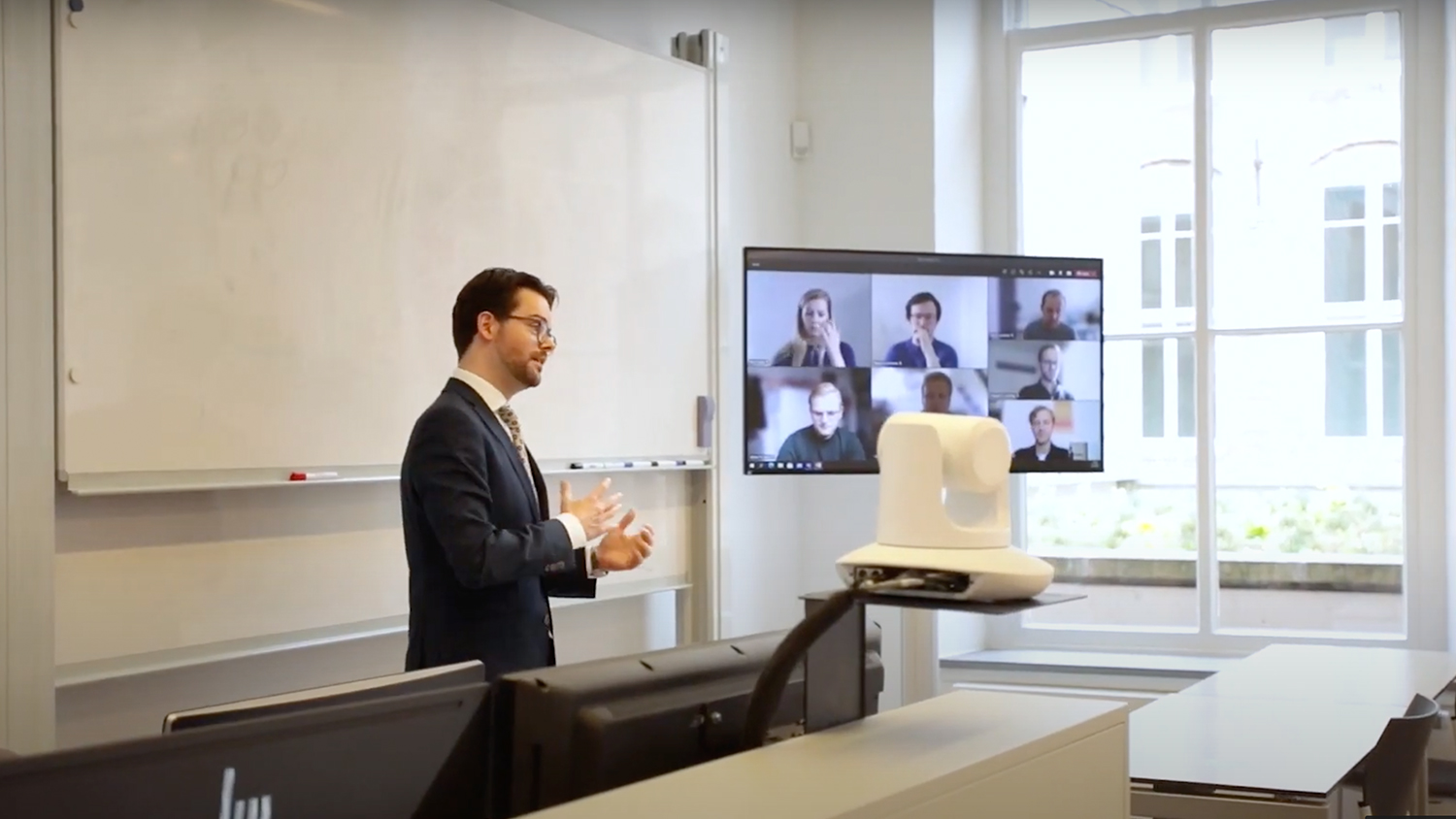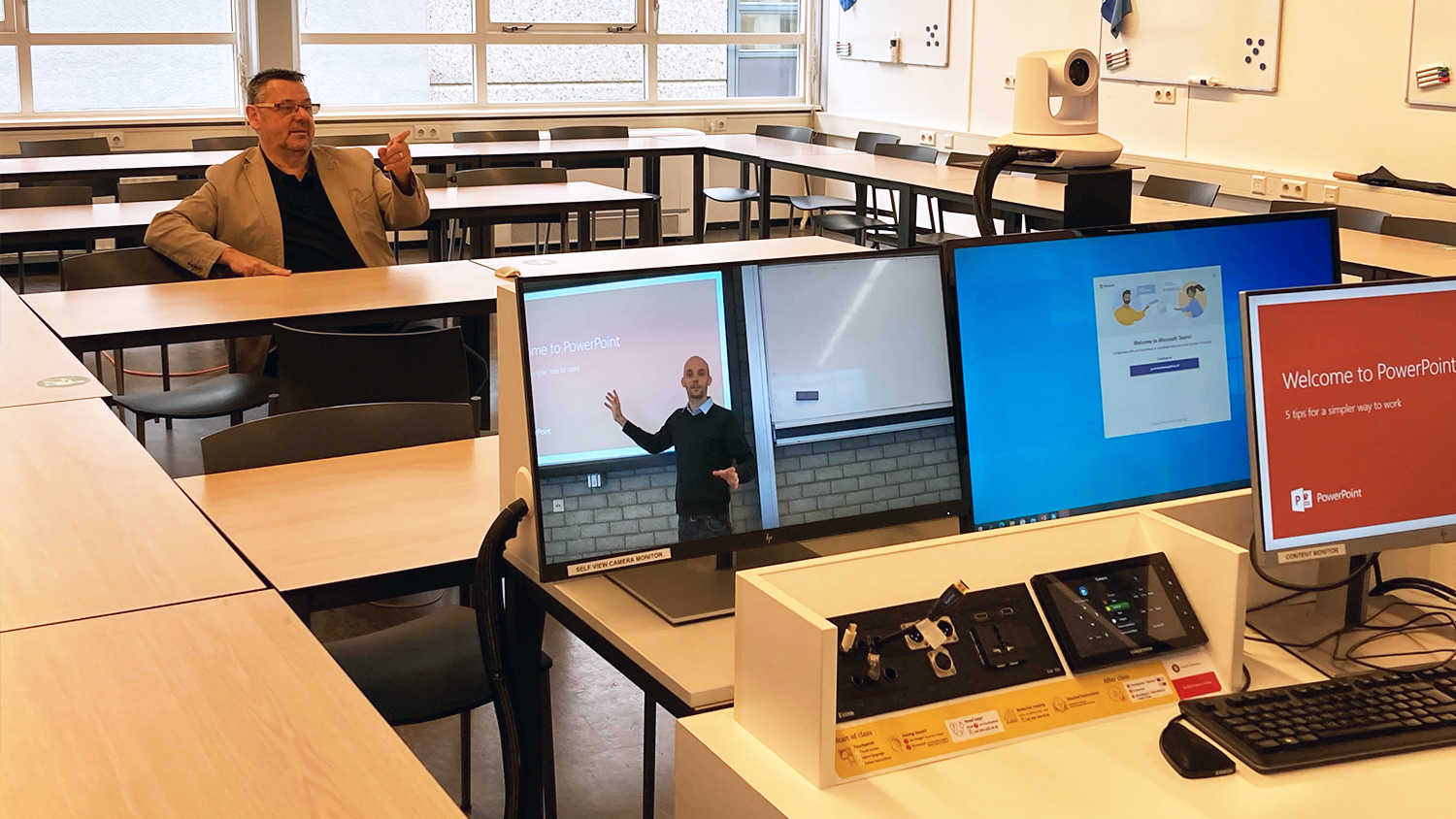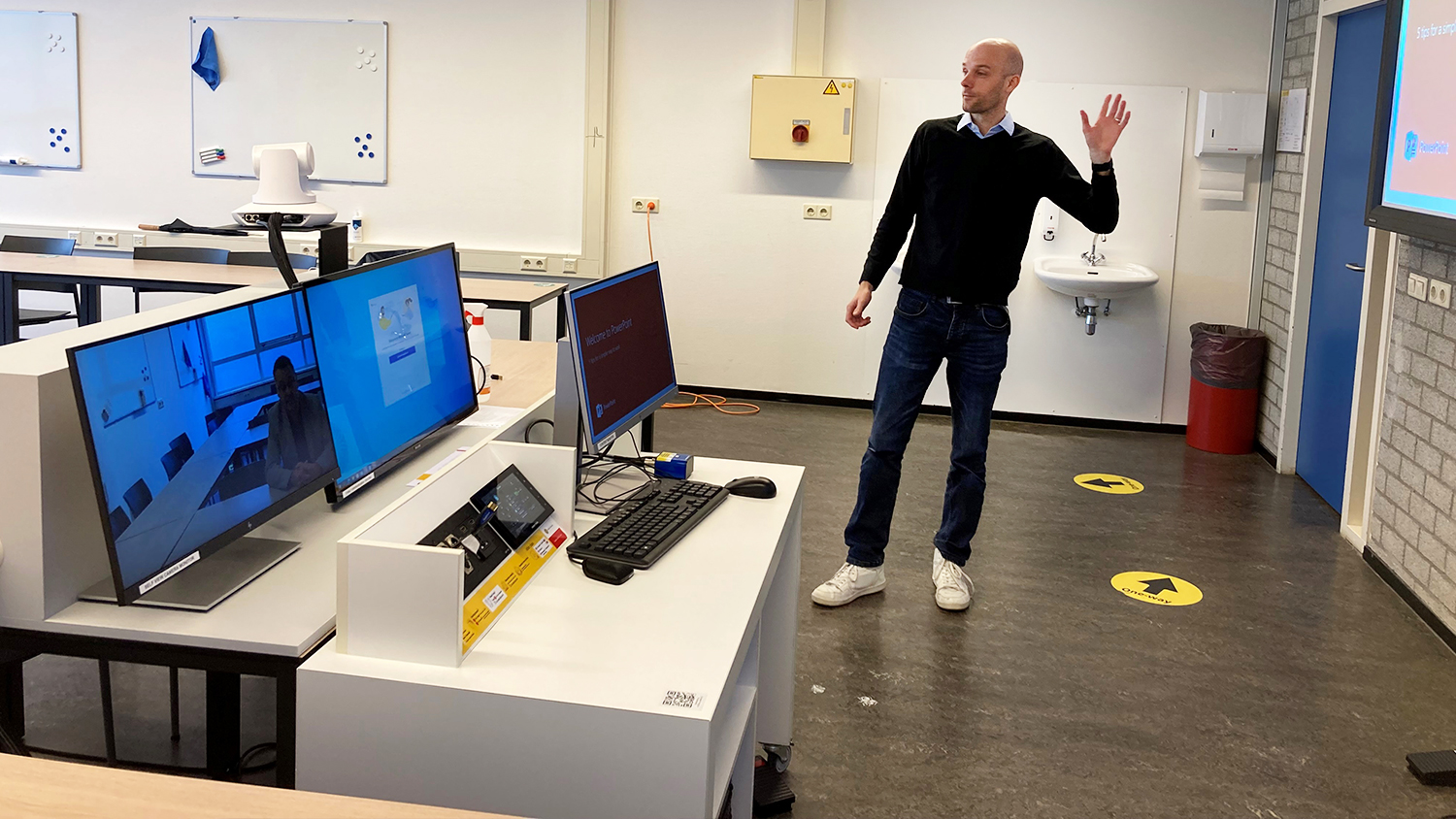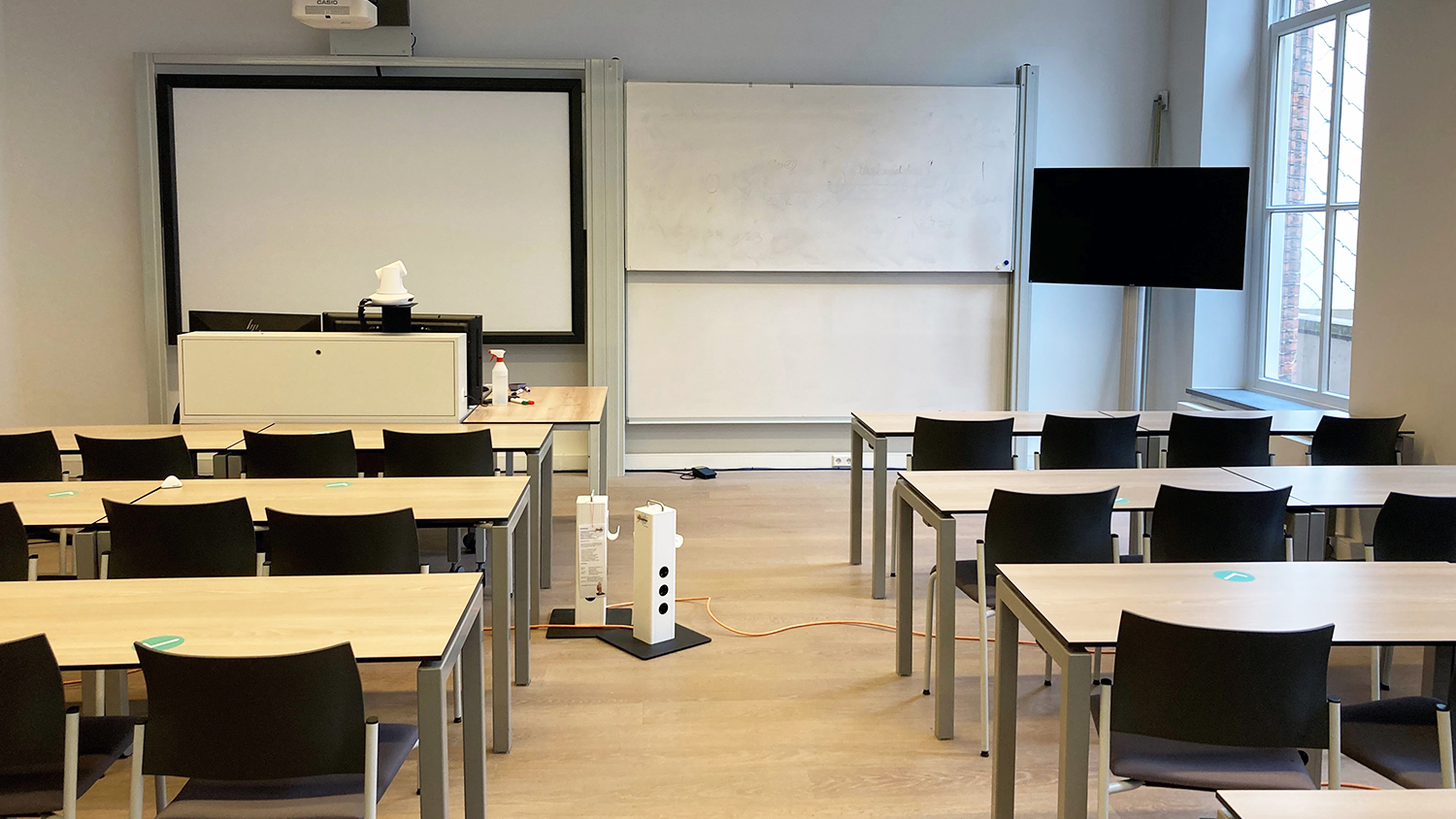How hybrid education got off the ground during the pandemic

The first time Law teacher Etzel van Dooren had to do his job in front of a webcam, back in March 2020, when the university went through its first lockdown, he didn't like it at all. Back then, the server’s capacity was still insufficient, so students had to switch off their microphones and cameras. He was basically speaking to a screen showing his own PowerPoint presentation.
After the server capacity was expanded, van Dooren was able to see his students and hear their voices, but he still didn't enjoy having a discussion with stamp-sized faces, while his presentation occupied almost the entire screen. "It wasn’t an inspiring form of education for anyone. The hardest thing for me was not having an outlet for my energy, I couldn’t walk around, I couldn’t move, couldn’t stir up a conversation between the students." He thought to himself: "is there really no other way of doing this?"
Along came the pedal room
He took this and other questions to the Future Learning Spaces project team, a research group on future learning spaces involving Educate-it, the Audio-visual & Media Productions department, Real Estate & Campus, and the Facility Services Centre. For several years now, Educate-it has been working hard to make education more hybrid, for example by recording lectures and tutorials. They were already experimenting with a virtual classroom when the pandemic broke out. "We were already working on educational innovation, so when the question arose as to how we could make online education more dynamic, the AV department came up with the 'pedal room', the predecessor of the work group room, with a hybrid function," recollects Len Dijstelbloem from Educate-it.
Gido van den Hengel and Henny Ram, of the AV-department, proudly show us the pedal room, a small classroom at the Bolognalaan. One of the walls is covered by big screens alongside a whiteboard. Underneath the screens and whiteboard, one can see a foot pedal on the ground. A bit further away from the wall, there’s a desk with a control panel, a desktop computer and three screens, above which towers a camera that can turn 360 degrees. The teacher, who stands between the desk and the wall with the screens and the whiteboard, is able to steer the camera by using the foot pedals. By aiming it at different screens, the teacher can control what students at home can see.
Etzel van Dooren was one of the first teachers to use this new classroom in September 2020. He was immediately sold. He could finally move around while teaching, write on the whiteboard, and see his students' faces on the big computer screen. "The set-up looks like a pre-pandemic class, only virtual. It has enabled me to teach an online class in a dynamic way."
En route to hybrid teaching
 Etzel van Dooren, still from a UU YouTube-video
Etzel van Dooren, still from a UU YouTube-video
Meanwhile, many were wondering how classes would be resumed once students were allowed back on campus. What would be feasible? What if the government would only allow small groups to have classes on location? How would the university be able to make online classes more interactive in such a scenario? According to Len Dijstelbloem, the pedal room was a great optiona s teachers would only have to teach on location once, with part of the students following the class simultaneously from home.
Apart from the practical benefits of allowing students who are in quarantine or stuck abroad to attend class anyway, hybrid education poses some "didactic challenges," in the words of Dijstelbloem. Classes should be interactive, for example. "There should be an interaction going on between the teacher and the students, and between the students mutually. But a prerequisite for that is that everyone should be able to hear and see each other. Students are often less involved with their classes when they take place online, so interaction between students is not a given. We strive for both groups of students to be able to participate equally in the classroom, so they feel like they belong to a single, unified community. That does require some effort from a teacher though."
A pilot with 23 classrooms
The idea was embodied in a pilot in which classrooms were prepared to go hybrid with regard to room design, technique, and didactics. The Executive Board also saw the potential in it. Although innovations are often tried out sparsely, and only ‘rolled out’ after an extensive evaluation, there was an immediate and substantial investment to make hybrid education possible. For block four of the previous college year, 23 classrooms were provided with the necessary items. Right on time for the minor relaxation of the Covid measures: since April 26, 2021, about one third of the classes can take place on-campus again.
 Len Dijstelbloem in May 2021 during a teacher’s workshop, private photo
Len Dijstelbloem in May 2021 during a teacher’s workshop, private photo
Teachers received manuals and workshops about the technical possibilities and didactic scenarios. At first, there wasn’t much enthusiasm. Not all teachers had the energy to embrace a new challenge after the switch to online teaching they’d made earlier. Not Etzel van Dooren, though, he couldn’t wait to invite his Master’s students to the hybrid room.
"This type of teaching has so much potential. Students who like to be physically present can come to class again. But if you can’t come – because you or one of your family members is part of a high-risk group for example, you can still follow class from home, you don’t have to miss anything. It also makes it possible for people on the other side of the world to attend the class and actively participate in the discussion."
Examine the possibilities of hybrid education
Following the experiences of block four, the Executive Board wanted to decide on an extension of the number of hybrid classrooms for the new academic year. An evaluation would orient their choice. Teachers and students were asked about the technique, layout, support, and didactics. Dijstelbloem: '"the first experiences teachers and students had with hybrid education were positive, but we didn’t have enough input to reach proper conclusions. We don’t want hybrid education to become a goal for emergency situations like a lockdown. This shape of education must have added value in itself."
Even so, all parties saw this added value. One of the programmes making use of it is the new Master's programme Charm EU, which debuted this academic year. The programme involves five European universities, including UU. The students are spread along the five universities and have to follow class together. "With a hybrid classroom, this is possible," Dijstelbloem says. Teacher van Dooren also sees numerous possibilities. "This is only the beginning. With hybrid teaching, students from abroad who cannot get the same level of education in their own country, and don’t have the resources to travel to our country, can still follow our classes and get access to quality education that way."

Henny Ram with Gido van den Hengel on the screen
The Executive Board identified the same opportunities and opted for a practical solution. The board decided to expand the number of hybrid classrooms to 44, which means an invesment of about 600,000 euros. "If hybrid education turns out to be disappointing, those classrooms can easily be dismantled and the equipment can be used elsewhere at the university. Moreover, the classrooms can now be used for classes that are fully or solely on location."
The AV department worked hard all summer long to turn 21 classrooms into hybrid rooms, according to Henny Ram. Five can be found on the international campus, sixteen in the city centre and 23 at Utrecht Science Park. "The classrooms in our building at the Bolognalaan are in great demand among teachers," says Gido van den Hengel, whose workplace is further along the corridor. Since this academic year, they can be booked through the regular timetable. The AV department also set up a pool of working students who can support the teachers with technology issues.
Teacher and director in one
The hybrid classroom looks exactly like the first pedal room, with the difference that there are tables and chairs on the other side of the desk where – depending on the space – twenty-four to eighty students can take place. The camera can also capture these students, while a room microphone captures their questions so that they can be heard by those following the class through Teams. But the teacher does have to press the right buttons on the desk to make that happen.
Henny Ram and Gido van den Hengel, of the Audio-visual & Media productions department, demonstrate the options. Van den Hengel plays the teacher, while Ram plays the student. From left to right, Ram sees the screen with the PowerPoint presentation, the whiteboard, and the screen with the fellow students on Teams.
When Ram asks a question, Van den Hengel points the camera at Ram with the push of a button and turns on the microphone. This way, the students on Teams can not only hear what Ram is saying, but also see who Ram is. If a student asks a question through Teams, it can also be seen and heard by everyone in the classroom. On a screen on the desk, Van den Hengel sees what the students in Teams are seeing. As a teacher, you are the visual director of your own class.
 Gido van den Hengel with Henny Ram on the screen
Gido van den Hengel with Henny Ram on the screen
Education in a hybrid college hall
In hybrid classroom 0.19 at Janskerkhof, Gabriëlle Creemers is prepping her presentation and installing her laptop to record the lecture. Meanwhile, about fifteen students stroll in. A lecture on Registered Property Law is scheduled today.

Hybrid lecture hall at Janskerkhof.
The reasons for Creemers to record her lecture in this hybrid room are both practical and didactic. "Lecturing on location is most alluring to me, but not all the 150 third-year students who follow this course are allowed to be in a lecture hall due to the Covid restrictions", she explains. Another reason is that she wants to make her recorded lecture more dynamic and she can do that here, as the room allows her to walk back and forth between the big screen and the whiteboard. Last year, she gained some experience with this type of teaching in the pedal room at Bolognalaan. It was "the next best thing", she says, and her students agreed. "We got great feedback."
Now she’s taking it to the next level by recording her lecture with some of her students in the classroom. "They can register for it. First come, first served. Every week, about fifteen students join in. The rest of them watch the recording the next day. "The work groups are all on location, she emphasizes. "Live, unless someone can’t come to class because of Covid, then they can join through Teams."
It is clear that the students present are keen to take part. They are all actively participating. At Creemers' request, they flip to page 201, answer her questions, and regularly ask one themselves. Creemers only allows the camera to rotate from PowerPoint to Whiteboard. For privacy reasons, the attending students are not shown on camera and the room microphone is not being used, either. Questions from the room are repeated or incorporated in the answer.
The fact that the other students aren’t simultaneously following this lecture through Teams has a practical reason. "I didn’t want to go full-fledged hybrid yet. Instead, I wanted to explore hybrid education one step at a time. With a small group on campus, it would have less impact to solve possible technical teething problems, but luckily I have yet to experience the first one."
She keeps learning more and more with each class and her confidence is growing, she says one week later. "I’m so enthusiastic about the possibilities. The combination of PowerPoint, whiteboard, and the interaction with students on location works really well. Should I be teaching in a hybrid classroom again, then I would like to include students participating live through Teams. Then they will add a third screen for me. That should work."
Student Thomas is pleased with the option to attend the lecture live. "I've been sitting at home starring at my computer screen for a year and a half and, by sitting here, I'm encouraged to think along more actively. I find that particularly useful because it keeps me extra engaged with the subject matter. And with such a small number of students, it feels like a private lesson."
Story continues after this video of a hybrid class of Etzel van Dooren
Further development
Teaching a ‘full-fledged’ hybrid class, which requires the teacher to keep an eye on different screens while managing the interaction between all students, is quite demanding on the teacher, admits Len Dijstelbloem, who teaches hybrid education to teachers herself. "The first time I did it, I noticed that I was still looking into the camera most of the time, trying to involve the students who were participating through Teams. As a result, I paid less attention to the students who were present in the classroom." But what she really wanted to was distribute her attention evenly. "But I've been finding a way around that more and more. Since the equipment is easy to operate, I don't think the technical side is the most difficult part of hybrid education."
According to Dijstelbloem, hybrid classes fit right in UU's education model, which is all about small-scaleness and interactivity. "The hybrid classrooms are actually also setup for teaching work lectures, but this type of education is still in its infancy and research is needed to gain more knowledge about it. How do you approach this type of education as a teacher? Where can we find improvements, what is needed for the future and what do students think of hybrid education?"
Dijstelbloem has evaluation forms ready for teachers and for students."Their experiences are highly valuable and indispensable," he says. The evaluation is also meant to be shared with other institutions. "Everyone is busy reinventing themselves and various universities are experimenting with hybrid education. But others are interested in what we are doing."
This doesn’t come as a surprise to enthusiast Etzel van Dooren: "This form of hybrid education is only the beginning. There’s still plenty to improve, of course, but if you think about what we’ve accomplished in just a year and a half, I think we can only be proud of how far we’ve come. I am curious about the options for the future. There’s still a world to gain out there. Where will we be next year?"